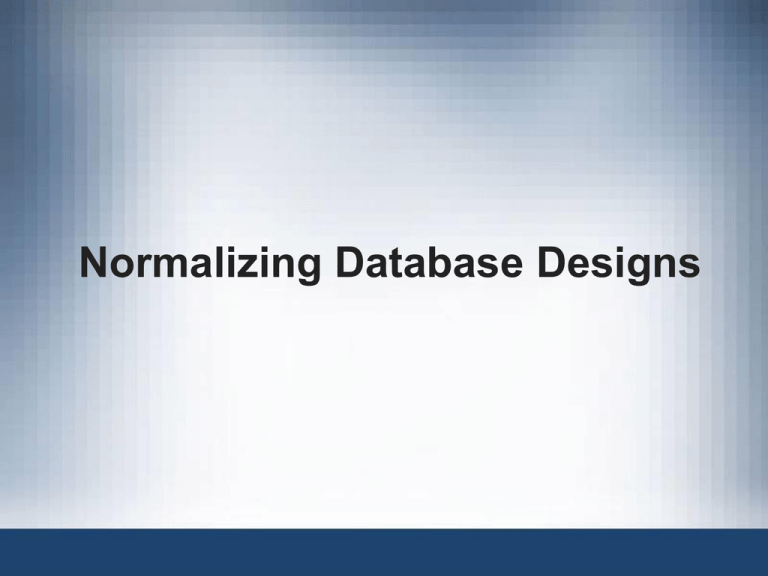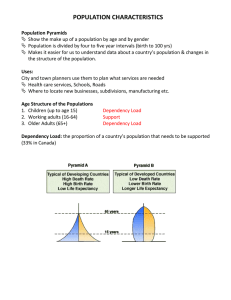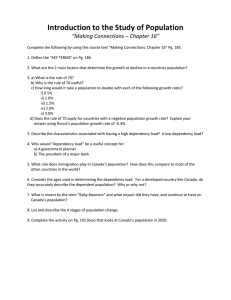
Normalizing Database Designs
Objectives
• In this chapter, students will learn:
– What normalization is and what role it plays in
the database design process
– About the normal forms 1NF, 2NF, 3NF
2
Database Tables and Normalization
• Normalization
– Process for evaluating and correcting table
structures to minimize data redundancies
• Reduces data anomalies
– Series of stages called normal forms:
• First normal form (1NF)
• Second normal form (2NF)
• Third normal form (3NF)
3
Database Tables and Normalization
(cont’d.)
• Normalization (continued)
– 2NF is better than 1NF; 3NF is better than 2NF
– For most business database design purposes,
3NF is as high as needed in normalization
– Highest level of normalization is not always most
desirable
• Denormalization produces a lower normal form
– Increased performance but greater data
redundancy
4
The Need for Normalization
• Example: company that manages building
projects
– Charges its clients by billing hours spent on
each contract
– Hourly billing rate is dependent on employee’s
position
– Periodically, report is generated that contains
information such as displayed in Table 6.1
5
6
© 2013 Cengage Learning. All Rights Reserved. This edition is intended for use outside of the U.S. only, with content that may be different from the U.S. Edition.
May not be scanned, copied, duplicated, or posted to a publicly accessible website, in whole or in part.
The Need for Normalization (cont’d.)
• Structure of data set in Figure 6.1 does not
handle data very well
• Table structure appears to work; report is
generated with ease
• Report may yield different results depending on
what data anomaly has occurred
• Relational database environment is suited to
help designer avoid data integrity problems
7
The Normalization Process
• Each table represents a single subject
• No data item will be unnecessarily stored in
more than one table
• All nonprime attributes in a table are dependent
on the primary key
• Each table is void of insertion, update, and
deletion anomalies
8
9
© 2013 Cengage Learning. All Rights Reserved. This edition is intended for use outside of the U.S. only, with content that may be different from the U.S. Edition.
May not be scanned, copied, duplicated, or posted to a publicly accessible website, in whole or in part.
The Normalization Process (cont’d.)
• Objective of normalization is to ensure that all
tables are in at least 3NF
• Higher forms are not likely to be encountered in
business environment
• Normalization works one relation at a time
• Progressively breaks table into new set of
relations based on identified dependencies
10
Functional Dependency
• Functional dependency is a relationship that
exists when one attribute uniquely determines
another attribute.
• If R is a relation with attributes X and Y, a
functional dependency between the attributes is
represented as X->Y, which specifies Y is
functionally dependent on X. Here X is a
determinant set and Y is a dependent attribute.
Each value of X is associated precisely with
one Y value.
11
© 2013 Cengage Learning. All Rights Reserved. This edition is intended for use outside of the U.S. only, with content that may be different from the U.S. Edition.
May not be scanned, copied, duplicated, or posted to a publicly accessible website, in whole or in part.
Partial Dependency
– non-key attribute of a table in a database is
dependent on the value of only a part of the
table’s primary key but not the entire primary
key.
Example: Given a relation R(A,B,C,D,E) ,
Functional
Dependency
:
AB→CDE
,
Primary_key(or simply 'key') is AB.
Then A→C : is a Partial Dependency
A→D : is a Partial Dependency
A→E : is a Partial Dependency
B→C : is a Partial Dependency
B→D : is a Partial Dependency
12
B→E : is a Partial Dependency
Transitive Dependency
• If the value in a non-key attribute is determined
by the value in another non-key attribute then
that field has transitive dependency. For
example, look at the relation below:
• The attribute teacher_name is determined by the
non-key attribute teacher_id, and not the primary key
of course_id. This means that teacher_name is
transitively dependent on the primary key of
course_id.
Conversion to First Normal Form
• Repeating group
– Group of multiple entries of same type can exist
for any single key attribute occurrence
• Relational table must not contain repeating
groups
• Normalizing table structure will reduce data
redundancies
• Normalization is three-step procedure
14
Conversion to First Normal Form
(cont’d.)
• Step 1: Eliminate the Repeating Groups
– Eliminate nulls: each repeating group attribute
contains an appropriate data value
• Step 2: Identify the Primary Key
– Must uniquely identify attribute value
– New key must be composed
• Step 3: Identify All Dependencies
– Dependencies are depicted with a diagram
15
16
© 2013 Cengage Learning. All Rights Reserved. This edition is intended for use outside of the U.S. only, with content that may be different from the U.S. Edition.
May not be scanned, copied, duplicated, or posted to a publicly accessible website, in whole or in part.
Conversion to First Normal Form
(cont’d.)
• Dependency diagram:
– Depicts all dependencies found within given
table structure
– Helpful in getting bird’s-eye view of all
relationships among table’s attributes
– Makes it less likely that you will overlook an
important dependency
17
18
© 2013 Cengage Learning. All Rights Reserved. This edition is intended for use outside of the U.S. only, with content that may be different from the U.S. Edition.
May not be scanned, copied, duplicated, or posted to a publicly accessible website, in whole or in part.
Conversion to First Normal Form
(cont’d.)
• First normal form describes tabular format:
– All key attributes are defined
– No repeating groups in the table
– All attributes are dependent on primary key
• All relational tables satisfy 1NF requirements
• Some tables contain partial dependencies
– Dependencies are based on part of the primary
key
– Should be used with caution
19
Conversion to Second Normal Form
• Step 1: Make New Tables to Eliminate Partial
Dependencies
– Write each key component on separate line,
then write original (composite) key on last line
– Each component will become key in new table
• Step 2: Reassign Corresponding Dependent
Attributes
– Determine attributes that are dependent on
other attributes
– At this point, most anomalies have been
eliminated
20
21
© 2013 Cengage Learning. All Rights Reserved. This edition is intended for use outside of the U.S. only, with content that may be different from the U.S. Edition.
May not be scanned, copied, duplicated, or posted to a publicly accessible website, in whole or in part.
Conversion to Second Normal Form
(cont’d.)
• Table is in second normal form (2NF) when:
– It is in 1NF and
– It includes no partial dependencies:
• No attribute is dependent on only portion of
primary key
22
Conversion to Third Normal Form
• Step 1: Make New Tables to Eliminate
Transitive Dependencies
– For every transitive dependency, write its
determinant as PK for new table
– Determinant: any attribute whose value
determines other values within a row
23
Conversion to Third Normal Form
(cont’d.)
• Step 2: Reassign Corresponding Dependent
Attributes
– Identify attributes dependent on each
determinant identified in Step 1
• Identify dependency
– Name table to reflect its contents and function
24
25
© 2013 Cengage Learning. All Rights Reserved. This edition is intended for use outside of the U.S. only, with content that may be different from the U.S. Edition.
May not be scanned, copied, duplicated, or posted to a publicly accessible website, in whole or in part.
Conversion to Third Normal Form
(cont’d.)
• A table is in third normal form (3NF) when both
of the following are true:
– It is in 2NF
– It contains no transitive dependencies
26
27
© 2013 Cengage Learning. All Rights Reserved. This edition is intended for use outside of the U.S. only, with content that may be different from the U.S. Edition.
May not be scanned, copied, duplicated, or posted to a publicly accessible website, in whole or in part.
28
© 2013 Cengage Learning. All Rights Reserved. This edition is intended for use outside of the U.S. only, with content that may be different from the U.S. Edition.
May not be scanned, copied, duplicated, or posted to a publicly accessible website, in whole or in part.
Denormalization
• Creation of normalized relations is important
database design goal
• Processing requirements should also be a goal
• If tables are decomposed to conform to
normalization requirements:
– Number of database tables expands
29
Denormalization (cont’d.)
• Joining the larger number of tables reduces
system speed
• Conflicts are often resolved through
compromises that may include denormalization
• Defects of unnormalized tables:
– Data updates are less efficient because tables
are larger
– Indexing is more cumbersome
– No simple strategies for creating virtual tables
known as views
30
31
© 2013 Cengage Learning. All Rights Reserved. This edition is intended for use outside of the U.S. only, with content that may be different from the U.S. Edition.
May not be scanned, copied, duplicated, or posted to a publicly accessible website, in whole or in part.





